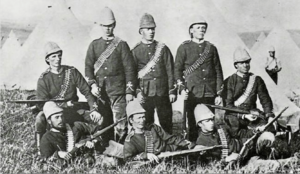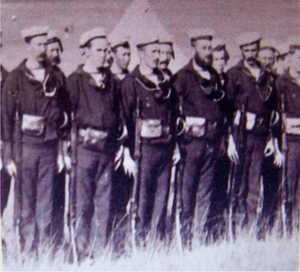Swinburn–Henry facts for kids
Quick facts for kids Swinburn–Henry rifle |
|
|---|---|

Sir Evelyn Wood’s bodyguard during the Anglo-Zulu War with Swinburn–Henry carbines.
|
|
| Place of origin | United Kingdom |
| Service history | |
| In service | 1870s |
| Used by | Colony of Natal |
| Wars | Anglo-Zulu War |
| Production history | |
| Designer | J. S. Swinburn |
| Designed | 1872 |
| Manufacturer | Abingdon Gun Works |
| Specifications | |
| Mass | 9 lb (4.1 kg) |
| Length | 49+1⁄4 in (1,250 mm) |
| Barrel length | 33+1⁄4 in (840 mm) |
|
|
|
| Cartridge | .577/450 Martini–Henry |
| Calibre | .455 in (11.6 mm) |
| Action | Falling-block |
| Feed system | Single-shot |
| References | The South African Military History Society |
| Swinburn–Henry carbine | |
|---|---|
| Specifications | |
| Mass | 7 lb 2 oz (3.2 kg) |
| Length | 39+1⁄2 in (1,000 mm) |
| Barrel length | 23+1⁄4 in (590 mm) |
| References | The South African Military History Society |
The Swinburn–Henry rifle was a special type of gun used in the late 1870s. It was a single-shot rifle, meaning you loaded one bullet at a time. British forces used it when their main rifle, the Martini–Henry, was hard to find. This rifle was loaded from the back (breech-loading) and had a lever to help load it.
Contents
How the Swinburn–Henry Rifle Was Designed
The Swinburn–Henry rifle looked a lot like the Martini–Henry rifle. But inside, they were quite different! Both rifles loaded bullets from the back. They used a "falling block" system. This means a block of metal moved down to open the space where you put the bullet.
To load the gun, you would pull a lever under the rifle. This opened the breech, which is the back part of the barrel where the bullet goes. The Swinburn–Henry had a special V-shaped spring and a hammer to hit the firing pin. The firing pin then hit the bullet to make it fire.
Special Features of the Swinburn–Henry
One big difference was how you could cock the hammer. On the Swinburn–Henry, you could use a thumb lever on the side to cock the hammer without moving the main loading lever. This was a great advantage! It meant soldiers could carry the rifle cocked in a saddle bag. There was less risk of it accidentally firing.
The Swinburn–Henry also used the same powerful bullet as the Martini–Henry. This was helpful because soldiers didn't need different types of ammunition. The Swinburn design was clever enough to avoid copying the Martini's patented design. However, in real use, the Swinburn–Henry was sometimes more delicate and could jam more often than the Martini.
Rifle Version Details
The Swinburn–Henry rifle had a barrel that was about 33 and a quarter inches long (84.5 centimeters). It weighed about 9 pounds (4.1 kilograms). Its sights could be set to hit targets up to 1,300 yards (about 1,189 meters) away. This rifle was usually given to foot soldiers. They often used it with a special sword-like bayonet. Naval volunteers sometimes used a cutlass bayonet with their rifles.
Carbine Version Details
The Swinburn–Henry carbine was a shorter version of the rifle. It had a barrel about 23 and a quarter inches long (59.1 centimeters). It weighed about 7 pounds and 2 ounces (3.2 kilograms). Its sights could hit targets up to 800 yards (about 732 meters) away. Carbines were usually given to soldiers on horseback and police officers. Some came with a Bowie knife bayonet, but these didn't work very well in battle.
History of the Swinburn–Henry
The Swinburn–Henry was designed by J. S. Swinburn in Birmingham, England. He got a patent for his design in 1872. All the rifles were made by the Abingdon Works Co. Ltd.
The Swinburn–Henry was used a lot by the volunteer soldiers in the Colony of Natal. This was a British colony in what is now South Africa. We don't know exactly how many were bought. But by 1878, the colony had received 2,040 carbines and 1,150 rifles. They also got 190 Bowie knife bayonets and some sword bayonets. The carbines went to mounted units, and the rifles went to foot soldiers. The Natal Mounted Police and naval volunteers also used these guns.
The Swinburn–Henry rifles were used by Natal's forces during the Anglo-Zulu War. The carbine version was especially common in the early parts of this war. Both the rifle and the carbine were eventually replaced by the Martini–Henry rifle.
See also
- Farquharson rifle


